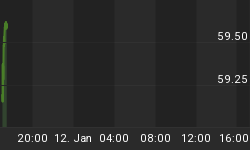I read this morning that global currencies expanded by 20% last year. As I mentioned a few months ago, the Chinese are expanding their currency at an average of 17-20% per year and other countries must match suit in order to dilute their currency a similar amount so it does not get overvalued. Also, it must be done for resources to be secured. The USD will eventually fall off a cliff, but the latest Elliott Wave count suggests it might be put off until 2009-2010 (Refer to Figure 4). The blue Fibonacci retracements are fore the decline from the recent top to the recent bottom and the red Fib retracements are for the entire move from the 2005 bottom to the 2005 top. The Bollinger bands are in a consolidation pattern, which likely will last until October/November.
Figure 1
The moving averages are nearing a focal point, with firm support in the dollar at 86. The full stochastics are on a longer term setting, with the %K recently hooking up. The upward time frame minimally will be one month. The Elliott Wave write up for Figure 4 is longer today, given the requirement for a thorough understanding about what has happened and what will happen. I would not want to be short the US dollar right now.
Figure 2
The weekly USD index is shown below with Fibonacci time extensions near the top of the chart and Fib retracements on the right hand side (red for the entire decline and blue for retracements of the current advance). All Fib time extensions come due at various points in 2006.The current decline of the USD hit the 38.2% level, showing strength in the index. The lower Bollinger bands are still basing and are in no position to signal a crash in the dollar. Rather, the pattern suggests a lengthy consolidation/rise lies ahead. The slanted blue line illustrates a sideways trend line initially established in 1998.The line is support/resistance and a move above will decisively show the USD heading higher. The 38.2% retracement shown in red (96ish) is the first likely price objective. The full stochastics below has a rising trend line in place from early 2003. The %K is above the %D and has no indication of curling beneath the %D at this point in time. The index likely will be going sideways over the next 4-6 years in a non-limiting triangle pattern before heading beneath 80.
Figure 3
After mentioning last week the USD had a likelihood for moving above the former high, careful review of all indices and placing human emotion aside with logic suggests the dollar is heading higher. I raised the Degree of the count across the board to keep the same labeling scheme in place the past six months. The initial wave up to [W] (most was an elongated flat ([W] used, because the elongated flat is one of three segments for the first leg of the developing triangle). This pattern is primarily found in expanding triangles as one leg or a segment of one leg. The current top pattern had a smaller Degree elongated flat decline, suggesting wave [X] will be a non-limiting triangle within the first leg of the triangle developing (make sense J ). Based upon the time frame of wave (A), waves (B), (C ), (D) and (E) must develop, so the pattern could develop until late October within the range of 87-90.5 before heading higher. A move below 86.8 would signal the labeling was in error and a decline to 82 should ensue. Based upon the overall picture of the developing wave structure of wave a, the time from start to finish will likely last 12-14 months. With four more wave segments, it places the USD going below 60 around or past 2010. This is when owning bullion and no gold stocks will be important. The price of gold should go absolutely ballistic at that point in time, lasting until 2010-2013. Do not short the dollar in the current upward force, and going long should have contracts with a peak of 96ish to be hit around December till February.
Figure 4
This is a typical publication seen throughout the week on our site. I do market analysis for the S&P 500 Index, AMEX Gold BUGS Index, AMEX Oil Index (XOI), US Dollar Index and the 10 Year US Treasury Index each week, along with the occasional stock recommendation. Anyone interested to know which way the above indices are headed through my work, or CaptainHooks exhaustive intermarket analysis can view our site at www.treasurechests.info.















